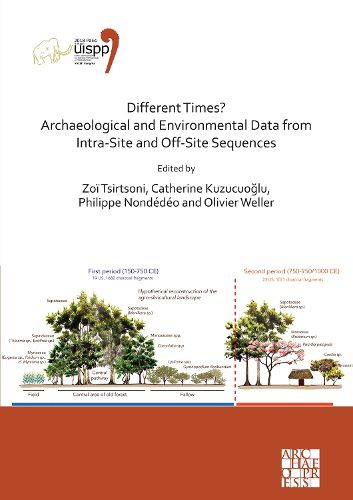Readings Newsletter
Become a Readings Member to make your shopping experience even easier.
Sign in or sign up for free!
You’re not far away from qualifying for FREE standard shipping within Australia
You’ve qualified for FREE standard shipping within Australia
The cart is loading…






Different Times? Archaeological and environmental data from intra-site and off-site sequences brings together seven papers from Session II-8 of the XVIII UISPP Congress (Paris, 4-9 June 2018). The session questioned temporal correlations between intra-site and off-site data in archaeology-related contexts. The word ‘site’ describes here archaeological sites or groups of sites - usually settlements - that have undergone research in recent years and produced information on the duration and timing of human presence. Comparison with evidence from geomorphological and paleoenvironmental research conducted at various distances from settlements gives some interesting results, such as ‘missing’ occupation periods, distortions in human presence intensity through space as well as time, variability in explanations concerning the abandonment of settlements, etc. Examples presented here highlight: first, discrepancies between time records within built areas used for living and the surrounding lands used for other activities (cultivation, herding, travelling, etc); second, discrepancies produced by the use of different ‘time markers’ (ie. chronostratigraphy of archaeological layers or pottery evolution on the one hand, sedimentary or pollen sequences on the other hand). Although improving the resolution of individual data is essential, the authors argue that the joint and detailed examination of evidence produced together by human and natural scientists is more important for reaching a reliable reconstruction of past people’s activities. Both the session and the volume stem from the Working Group ‘Environmental and Social Changes in the Past’ (Changements environnementaux et societes dans le passe) in the research framework of the Cluster of Excellence ‘Dynamite’ (Territorial and Spatial Dynamics) of the University Paris 1-Pantheon-Sorbonne (ANR-11-LABX-0046, Investissements d'Avenir).
$9.00 standard shipping within Australia
FREE standard shipping within Australia for orders over $100.00
Express & International shipping calculated at checkout
Different Times? Archaeological and environmental data from intra-site and off-site sequences brings together seven papers from Session II-8 of the XVIII UISPP Congress (Paris, 4-9 June 2018). The session questioned temporal correlations between intra-site and off-site data in archaeology-related contexts. The word ‘site’ describes here archaeological sites or groups of sites - usually settlements - that have undergone research in recent years and produced information on the duration and timing of human presence. Comparison with evidence from geomorphological and paleoenvironmental research conducted at various distances from settlements gives some interesting results, such as ‘missing’ occupation periods, distortions in human presence intensity through space as well as time, variability in explanations concerning the abandonment of settlements, etc. Examples presented here highlight: first, discrepancies between time records within built areas used for living and the surrounding lands used for other activities (cultivation, herding, travelling, etc); second, discrepancies produced by the use of different ‘time markers’ (ie. chronostratigraphy of archaeological layers or pottery evolution on the one hand, sedimentary or pollen sequences on the other hand). Although improving the resolution of individual data is essential, the authors argue that the joint and detailed examination of evidence produced together by human and natural scientists is more important for reaching a reliable reconstruction of past people’s activities. Both the session and the volume stem from the Working Group ‘Environmental and Social Changes in the Past’ (Changements environnementaux et societes dans le passe) in the research framework of the Cluster of Excellence ‘Dynamite’ (Territorial and Spatial Dynamics) of the University Paris 1-Pantheon-Sorbonne (ANR-11-LABX-0046, Investissements d'Avenir).